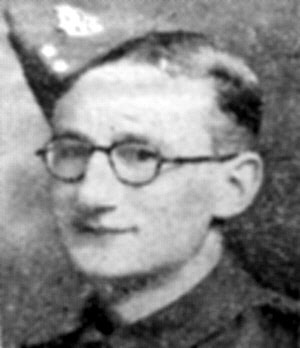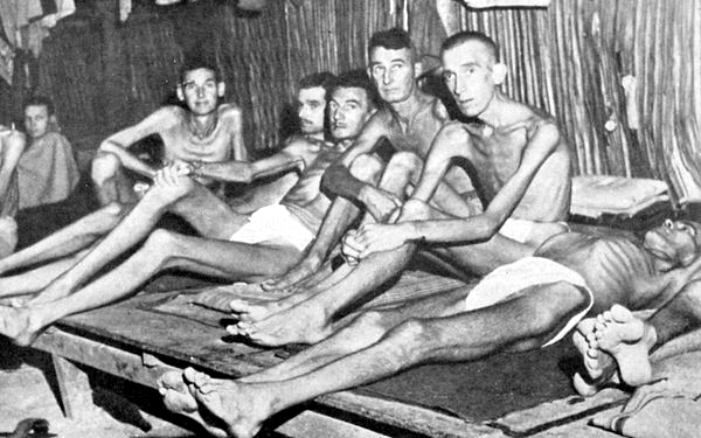
Clarance Alban Peace was born on the 31st October 1919, probably at Horbury Bridge. He was the son of Samuel Peace and Myra Howgate, who married at St. John The Divine Church, Horbury Bridge on the 21st December 1912. Samuel, an athletic worker was aged 31 years of Bridge Road, Horbury Bridge and Myra , aged 22 years was a weaver of ‘Stoneroyd’, Horbury Bridge.
In September 1939 Clarance, a bank clerk was living at The School House, Horbury with his parents, Samuel (born 16th October 1881), a sports and leather worker and Myra (born 21 November 1890). His sister Mabel (born 21 November 1890), was working as a clerk typist and his brother, Harvey H. (born 22 August 1921) worked as an automobile electrician. A sixth name in the household is redacted.
Myra Peace of Horbury died in September 1942, aged 51 years, and was buried at St. Peter and St. Leonard’s Church, Horbury on the 7th September 1942. Samuel, a widower, married Elizabeth Laycock in late 1943 and the couple lived at Woodkirk, Dewsbury. Samuel Peace died in September 1967.
Clarance Alban Peace otherwise Clarance Alban of Telephone Exchange, Westfield Road, Horbury died on the 1st June 1943 on war service. Administration, with Will, was granted at Wakefield on the 24th May 1945 to Samuel Peace, caretaker – operator. His effects were £149 1s 1d.
The Royal Army Ordnance Corps (RAOC) was both a supply and repair corps. In the supply area it had responsibility for weapons, armoured vehicles and other military equipment, ammunition and clothing and certain minor functions such as laundry, mobile baths and photography. The RAOC was also responsible for a major element of the repair of Army equipment. In 1942 the latter function was transferred to the Royal Electrical and Mechanical Engineers (REME) and the vehicle storage and spares responsibilities of the Royal Army Service Corps were in turn passed over to the RAOC. The RAOC retained repair responsibilities for ammunition, clothing and certain ranges of general stores.
Clarance Peace was captured by the Japanese during the invasion of Singapore in February 1942. Here is an account from a fellow RAOC recruit Sergeant Adam Gordon, who describes the horrors endured by Corporal Clarance Peace as forced slave labour on the Burma – Siam Railway.
Adam “Jock” Gordon, a former sergeant with the Royal Army Ordnance Corps. Sgt Gordon, 89, who lives in Worksop, Notts, joined the army in 1940 and arrived in Singapore on February 5th 1942. Ten days later he was a prisoner-of-war. “The Japanese attacks caught us by surprise and we were soon under heavy bombardment,” he said. Sgt. Gordon spent more than three years working on the Burma railway. It was hard labour, up to 14 hours a day, and disease took its toll. There were two funerals a day, at midday and 6pm, he said. “Sometimes the number of men buried at each funeral reached double figures.” He knows today will be “difficult” but says it is “important to remember our comrades who never made it home. I am a very lucky man”.1
The “Ossett Observer” had this obituary for Clarance Alban Peace:2
“Death in Jap hands – Corporal C.A. Peace, Horbury – Official information has been received that Corporal Clarance A. Peace, son of Mr. and the late Mrs. Sam Peace of the Telephone Exchange, Horbury, and late of the School House, Horbury Bridge, died whilst a prisoner of war in Japanese hands in June 1943, at the age of 23. Corporal Peace joined the colours in February 1940, was sent abroad in October 1941, and was captured at the fall of Singapore in 1942. During his captivity his father received one postcard from him in December 1943, six months after his death, which said he was ‘fit and well’. Corporal Peace was employed on the notorious Burma – Siam jungle railway.
In civilian life, he was employed as a clerk at Barclays Bank, Dewsbury. He was educated at Horbury Bridge School and Ossett Grammar School and won a choral scholarship at the age of eleven to Magdalen College, Oxford. He left Oxford at the age of 16½. Corporal Peace was the opening bat for Horbury Bridge St. John’s Cricket Club, and was well-known in cricket circles. He was a member of Horbury Vocal Class Choir, and took part in many competitive festivals when prizes were won. He sang bass in a quartet party along with his two sisters and a tenor member of the choir, Mr. H. Bradley. Corporal Peace won first prize in the Rothwell Choral Festival in 1938, where he also won the Founder Cup for gaining the greatest number of marks, thereby gaining the right to broadcast on the BBC, which he did later.”
Clarence Peace died as a Japanese prisoner of war in Burma on the 1st June 1943, aged 23 years, he is buried at grave reference B3. N. 16. in the Thanbyuzayat War Cemetery in Burma (now Myanmar). The village of Thanbyuzayat is 65 kilometres south of the port of Moulmein, and the war cemetery lies at the foot of the hills which separate the Union of Myanmar from Thailand.
The notorious Burma-Siam railway, built by Commonwealth, Dutch and American prisoners of war, was a Japanese project driven by the need for improved communications to support the large Japanese army in Burma. During its construction, approximately 13,000 prisoners of war died and were buried along the railway. An estimated 80,000 to 100,000 civilians also died in the course of the project, chiefly forced labour brought from Malaya and the Dutch East Indies, or conscripted in Siam (Thailand) and Burma (Myanmar).

Above: PoWs laying the railway. One died for each wooden sleeper.
Two labour forces, one based in Siam and the other in Burma worked from opposite ends of the line towards the centre. The Japanese aimed at completing the railway in 14 months and work began in October 1942. The line, 424 kilometres long, was completed by December 1943.
The graves of those who died during the construction and maintenance of the Burma-Siam railway (except for the Americans, whose remains were repatriated) were transferred from camp burial grounds and isolated sites along the railway into three cemeteries at Chungkai and Kanchanaburi in Thailand and Thanbyuzayat in Myanmar.
Thanbyuzayat became a prisoner of war administration headquarters and base camp in September 1942 and in January 1943 a base hospital was organised for the sick. The camp was close to a railway marshalling yard and workshops, and heavy casualties were sustained among the prisoners during Allied bombing raids in March and June 1943. The camp was then evacuated and the prisoners, including the sick, were marched to camps further along the line where camp hospitals were set up. For some time, however, Thanbyuzayat continued to be used as a reception centre for the groups of prisoners arriving at frequent intervals to reinforce the parties working on the line up to the Burma-Siam border.
Thanbyuzayat War Cemetery was created by the Army Graves Service who transferred to it all graves along the northern section of the railway, between Moulmein and Nieke. There are now 3,149 Commonwealth and 621 Dutch burials of the Second World war in the cemetery.3

Above: Severely malnourished and emaciated PoWs who were forced to work on the Burma-Thai “Death” Railway by the Japanese.
References:
1. ‘Forgotten army’ of POWs hold final remembrance service for fallen comrades
2. “Ossett Observer”, Saturday, January 15th, 1944